What is a storage fund endowment?
In the core mechanism of Arweave, there is a very important concept and component, which is the storage fund Endowment.
 JinseFinance
JinseFinance
Author: 0xai, AI creation platform Source: medium Translation: Shan Ouba, Golden Finance
Bittensor itself is not an AI product, nor does it produce or provide any AI products or services. Bittensor is an economic system that acts as an optimizer for the AI product market by providing a highly competitive incentive system for AI product producers. In the Bittensor ecosystem, high-quality producers receive more incentives, while less competitive producers are gradually eliminated.
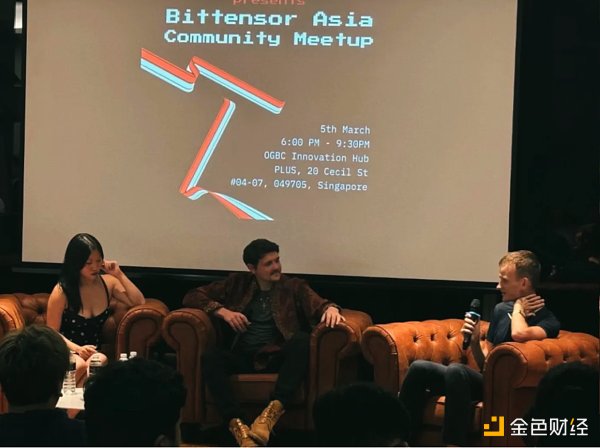
0xai team, Jacob and Vitalik in the group discussion
So, how does Bittensor create this incentive mechanism that encourages effective competition and promotes the organic production of high-quality AI products?
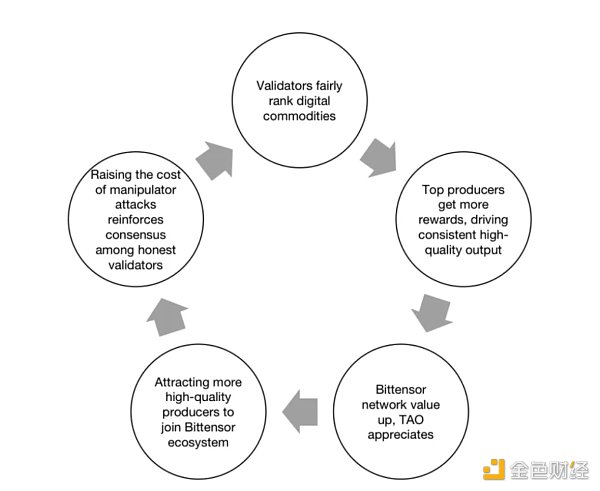
Bittensor Flywheel Model
Bittensor achieves this goal through a flywheel model. Validators evaluate the quality of AI products in the ecosystem and allocate incentives based on their quality, ensuring that high-quality producers receive more incentives. This stimulates the continuous increase in high-quality output, thereby enhancing the value of the Bittensor network and increasing the appreciation of TAO. The appreciation of TAO not only attracts more high-quality producers to join the Bittensor ecosystem, but also increases the attack cost for manipulators to manipulate quality evaluation results. This further strengthens the consensus of honest validators and enhances the objectivity and fairness of the evaluation results, thereby achieving a more effective competition and incentive mechanism.
Ensuring the fairness and objectivity of the evaluation results is a key step in turning the flywheel. This is also the core technology of Bittensor, namely the abstract verification system based on Yuma consensus.
So, what is Yuma consensus, and how does it ensure that the quality evaluation results after consensus are fair and objective?
Yuma consensus is a consensus mechanism that aims to calculate the final evaluation results from the diverse evaluations provided by many validators. Similar to the Byzantine Fault Tolerant consensus mechanism, as long as the majority of validators in the network are honest, the correct decision can be reached in the end. Assuming that honest validators can provide objective evaluations, the evaluation results after consensus will also be fair and objective.
Taking subnet quality evaluation as an example, the root network validator evaluates and ranks the quality of each subnet output. The evaluation results of the 64 validators are aggregated and the final evaluation results are obtained through the Yuma consensus algorithm. The final result is then used to allocate the newly created TAO to each subnet.
At present, the Yuma consensus does have room for improvement:
The root network validators may not fully represent all TAO holders, and the evaluation results they provide do not necessarily reflect a wide range of views. In addition, the evaluations of some top validators may not always be objective. Even if bias is discovered, it may not be corrected immediately.
The existence of the root network validator limits the number of subnets that Bittensor can accommodate. To compete with centralized AI giants, it is not enough to have only 32 subnets. However, even with 32 subnets, it may be difficult for the root network validator to effectively monitor all subnets.
The validator may not have a strong desire to migrate to a new subnet. In the short term, validators may lose some rewards when migrating from old subnets with higher emissions to new subnets with lower emissions. The uncertainty of whether the emissions of the new subnets will eventually catch up, coupled with the clear loss of rewards in the pursuit process, weakens their willingness to migrate.
Bittensor also plans to upgrade the mechanism to address these shortcomings:
Dynamic TAO will disperse the power to evaluate the quality of subnets to all TAO holders, rather than a few validators. TAO holders will be able to indirectly determine the allocation ratio of each subnet through staking.
Without the limit of the root network validator, the maximum number of active subnets will be increased to 1024. This will greatly reduce the threshold for new teams to join the Bittensor ecosystem, resulting in more intense competition between subnets.
Validators who migrate to new subnets earlier may receive higher rewards. Migrating to a new subnet early means buying dTAO of that subnet at a lower price, thereby increasing the possibility of receiving more TAO in the future.
Strong inclusiveness is also a major advantage of Yuma consensus. Yuma consensus is used not only to determine the emission of each subnet, but also to determine the distribution ratio of each miner and validator within the same subnet. Moreover, no matter what the miner's task is, the contributions it contains, including computing power, data, human contributions, and intelligence, are considered abstractly. Therefore, any stage of AI commodity production can access the Bittensor ecosystem, enjoying incentives while also enhancing the value of the Bittensor network.
Next, let's explore some leading subnets and observe how Bittensor incentivizes the output of these subnets.
You can contribute to the development of the myshell ai/MyShell TTS subnet by creating an account on GitHub.
Issuance: 3.46% (April 9, 2024)
Background: Myshell is the team behind Myshell TTS (text-to-speech), with core members from well-known institutions such as MIT, Oxford University, and Princeton University. Myshell aims to create a no-code platform that allows college students without a programming background to easily create the robots they want. Myshell focuses on the TTS field, audiobooks, and virtual assistants, and launched its first voice chatbot Samantha in March 2023. With the continuous expansion of the product matrix, there are currently more than one million registered users. The platform hosts various types of robots, including language learning, educational, and practical robots.
Positioning: Myshell launched this Subnet to pool the wisdom of the entire open source community to create the best open source TTS model. In other words, Myshell TTS does not directly run the model or process end-user requests; instead, it is a network for training TTS models.
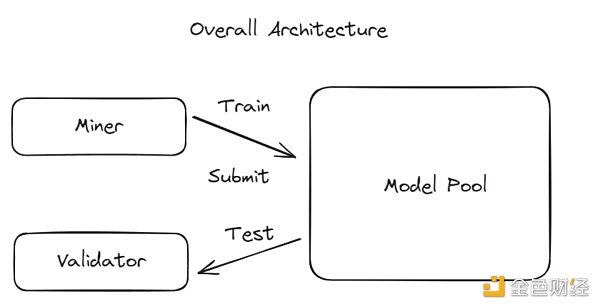
Myshell TSS Architecture
The process of Myshell TTS operation is shown in the figure above. Miners are responsible for training models and uploading trained models to the model pool (the metadata of the model is also stored in the Bittensor blockchain network); validators evaluate models by generating test cases, evaluating model performance, and scoring based on the results; the Bittensor blockchain is responsible for using the Yuma consensus to aggregate weights and determine the final weight and distribution ratio of each miner.
In short, miners must continue to submit higher quality models to maintain their rewards.
Currently, Myshell has also launched a demo on its platform for users to try out the models in Myshell TTS.
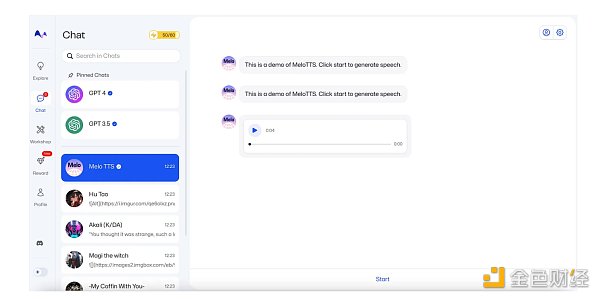
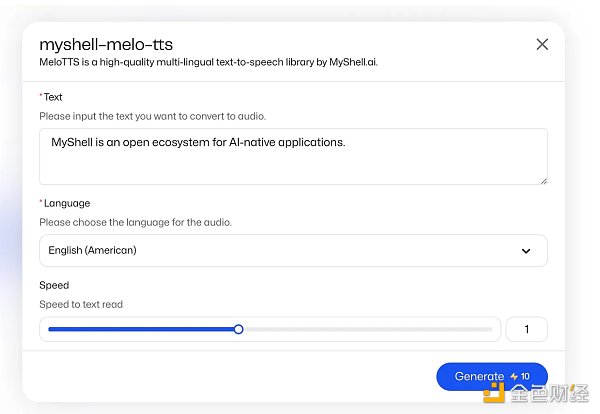
In the future, as the models trained by Myshell TTS become more reliable, more use cases will be launched. Moreover, as an open source model, they will not only be limited to Myshell, but can also be extended to other platforms. Isn’t it our goal in decentralized AI to train and incentivize open source models through this decentralized approach?
You can contribute to the development of Open Kaito by creating an account on GitHub.
Issuance: 4.39% (April 9, 2024)
Background: The team behind Kaito.ai is the Open Kaito team, whose core members have extensive experience in the field of artificial intelligence and have previously worked at first-class companies such as AWS, META, and Citadel. Before entering the Bittensor subnet, they launched their flagship product Kaito.ai, a Web3 off-chain data search engine, which was launched in the fourth quarter of 2023. Using artificial intelligence algorithms, Kaito.ai optimizes the core components of the search engine, including data collection, ranking algorithms, and retrieval algorithms. It has been recognized as a first-class information collection tool in the crypto community.
Positioning: Open Kaito aims to build a decentralized indexing layer to support intelligent search and analysis. A search engine is not just a database or ranking algorithm, but a complex system. In addition, an effective search engine also requires low latency, which poses additional challenges to building a decentralized version. Fortunately, through Bittensor's incentive system, these challenges are expected to be solved.
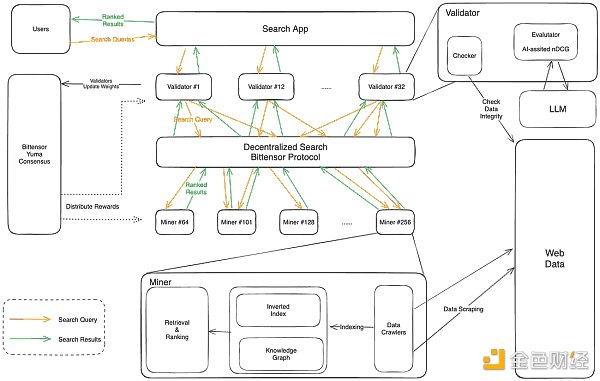
The operating process of Open Kaito is shown in the figure above. Instead of simply decentralizing each component of the search engine, Open Kaito defines the indexing problem as a miner-validator problem. That is, miners are responsible for responding to user indexing requests, while validators distribute requirements and score miners' responses.
Open Kaito does not restrict how miners complete indexing tasks, but focuses on the results of the miners' final output to encourage innovative solutions. This helps create a healthy competitive environment among miners. Faced with user indexing needs, miners work hard to improve execution plans and obtain higher quality response results with fewer resources.
You can contribute to the development of the Nous Research/finetuning subnet by creating an account on GitHub.
Issuance: 6.26% (April 9, 2024)
Background: The team behind Nous Finetuning comes from Nous Research, a research team focusing on large-scale language model (LLM) architecture, data synthesis, and on-device reasoning. Its co-founder served as the chief engineer of Eden Network.
Positioning: Nous Finetuning is a subnet dedicated to fine-tuning large language models. In addition, the data used for fine-tuning also comes from the Bittensor ecosystem, specifically Subnet 18.
Nous Finetuning operates similarly to Myshell TSS. Miners train models based on data from subnet 18 and periodically publish these models for hosting on Hugging Face; validators evaluate the models and provide scores; similarly, the Bittensor blockchain is responsible for aggregating weights using Yuma consensus to determine the final weight and issuance of each miner.
You can contribute to the development of corcel-api/cortex.t by creating an account on GitHub.
Issuance: 7.74% (April 9, 2024)
Background: The team behind Cortex.t is Corcel.io, which has received support from Mog, the second largest validator on the Bittensor network. Corcel.io is an end-user application that provides a similar experience to ChatGPT by leveraging the artificial intelligence products of the Bittensor ecosystem.
Positioning: Cortex.t is positioned as the last layer before providing results to end users. It is responsible for detecting and optimizing the outputs of various subnets to ensure that the results are accurate and reliable, especially when a single prompt calls multiple models. Cortex.t is designed to prevent blank or inconsistent outputs, ensuring a seamless user experience.
Miners in Cortex.t utilize other subnets in the Bittensor ecosystem to process requests from end users. They also use GPT 3.5 turbo or GPT 4 to verify the output results to ensure reliability to end users. Validators evaluate the output of miners by comparing them to the results generated by OpenAI.
Contribute to the development of namoray/vision by creating an account on GitHub.
Issuance: 9.47% (April 9, 2024)
Background: The development team behind Vision also comes from Corcel.io.
Positioning: Vision aims to maximize the output capacity of the Bittensor network by leveraging an optimized subnet building framework called DSIS (Distributed Scaled Inference Subnet). The framework accelerates the response of miners to validators. Currently, Vision focuses on the scenario of image generation.
Validators receive demands from the Corcel.io front end and distribute them to miners. Miners are free to choose their favorite technology stack (not limited to models) to process demands and generate responses. Then, validators evaluate the performance of miners. Thanks to the existence of DSIS, Vision is able to respond to these demands faster and more efficiently than other subnets.
From the above examples, we can see that Bittensor demonstrates a high degree of inclusiveness. The generation of miners and the verification of validators occur off-chain, and the Bittensor network distributes rewards to each miner based solely on the evaluation of the validator. Any aspect of AI product generation that fits the miner-validator architecture can be converted to a subnet.
In theory, competition between subnets should be fierce. For any subnet to continue to receive rewards, it must continue to produce high-quality output. Otherwise, if the root network validator deems the output of a subnet to be of low value, its allocation may be reduced, and it may eventually be replaced by a new subnet.
But in reality, we did find some problems:
Redundancy and duplication of resources due to similar subnet positioning. Among the 32 existing subnets, several subnets focus on popular directions such as text-to-image, text prompts, and price prediction.
There are subnets with no real use cases. Although the price prediction subnet may have theoretical value as an oracle provider, the current performance of the prediction data is far from being usable by end users.
An example of "bad money drives out good money". Some top validators may not have a strong desire to migrate to new subnets, even if some new subnets show significantly higher quality. However, due to lack of financial support, sufficient emissions may not be obtained in the short term. Since the protection period after the new subnet is launched is only 7 days, if sufficient emissions cannot be accumulated quickly, it may face the risk of being eliminated and offline.
These problems reflect that the competition between subnets is not sufficient, and some validators have not played a role in encouraging effective competition.
The Open Tensor Foundation Validator (OTF) has implemented some temporary measures to alleviate this situation. As the largest validator with 23% of the staking rights (including delegation), OTF provides a channel for subnets to compete for more Staked TAO: subnet owners can submit requests to OTF every week to adjust the proportion of their Staked TAO in the subnet. These requests must cover 10 aspects, including "subnet goals and contributions to the Bittensor ecosystem", "subnet reward mechanism", "communication protocol design", "data source and security", "computing requirements" and "roadmap" to facilitate the final decision of OTF.
However, to fundamentally solve this problem, on the one hand, we urgently need to launch dTAO (Dynamic TAO), which aims to fundamentally change the above unreasonable problems. Alternatively, we can call on large validators who hold a large amount of Stake TAO to consider the long-term development of the Bittensor ecosystem more from the perspective of "ecosystem development" rather than just from the perspective of "financial returns".
In summary, with its strong inclusiveness, fierce competition environment and effective incentive mechanism, we believe that the Bittensor ecosystem can organically produce high-quality artificial intelligence products. While not all outputs of existing subnets are comparable to those of centralized products, let’s not forget that the current Bittensor architecture is just one year old (subnet #1 was registered on April 13, 2023). For a platform that has the potential to compete with centralized AI giants, perhaps we should focus on proposing practical improvement plans instead of rushing to criticize its shortcomings. After all, none of us want to see AI continue to be controlled by a few giants.
In the core mechanism of Arweave, there is a very important concept and component, which is the storage fund Endowment.
 JinseFinance
JinseFinanceWe're still in the early stages of Bittensor, but all signs point to it being on the right track.
 JinseFinance
JinseFinanceAs a product of its times, Dogecoin has its own set of problems. DogeLayer is here to fix just that.
 Max Ng
Max NgNothing quite as scary as as innocent NFT holders unknowingly acquiring "money laundering tools.", and Tte platform's forensics data-driven approach protects holders from exactly that.
 Brian
Brian JinseFinance
JinseFinance JinseFinance
JinseFinance JinseFinance
JinseFinanceFriend.Tech, a decentralised social media platform, is a creation that melds technological prowess with human interaction, and orbits around the idea of crypto personalities — in short, the transformative utilisation of "shares" as digital assets.
 Catherine
Catherine Cointelegraph
CointelegraphIf you look at it literally, DAO is "Decentralized Autonomous Organization". Although its description is concrete, its meaning is abstract.
 Cointelegraph
Cointelegraph